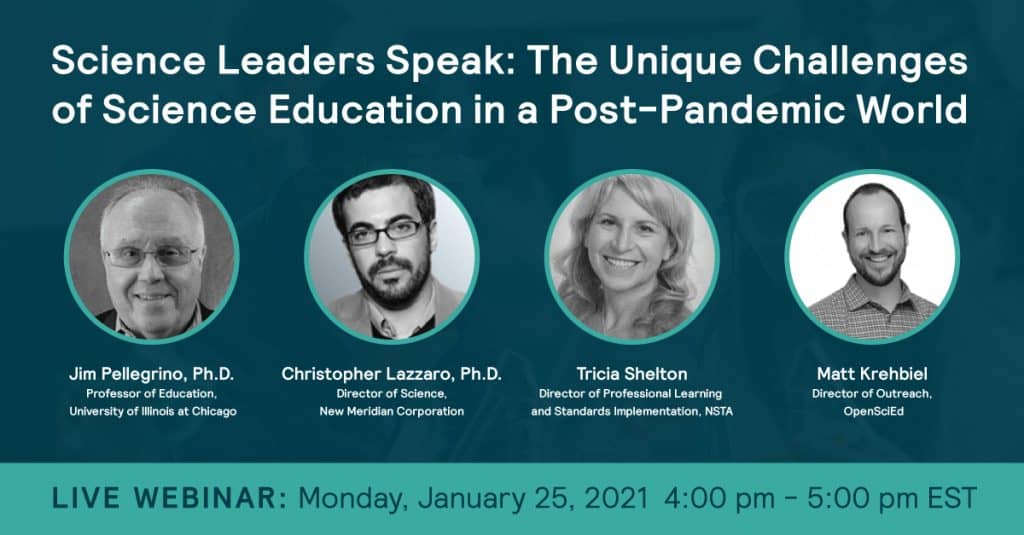
Last month was a big one for those of us who watch science education closely.
As the U.S. waits for the distribution of a life-saving vaccine developed in less than a year, and millions of students nationwide attend digital classes while parents work in similar fashion, the importance of science and technology in our lives could not be more clear. They are the very things that are holding American life together.
While 2020 will be remembered for the staggering toll wrought by the death of 300,000 Americans victimized by a cruel disease, it is also worth remembering that science and technology enabled our recovery and allowed those who escaped the coronavirus to move forward with their lives.
In the case to advance science education in American classrooms, there is simply no better argument.
International Test Scores
So, how are U.S. students doing in science? There is a great deal of data to dive into and much to be said. Keeping in mind that the PISA and TIMSS exams are international measures intended to compare multiple countries against a common set of educational indicators, and not against state educational standards, here are some basics:
- The Trends in International Mathematics and Science Study (TIMSS) exam measures math and science learning in grades 4 and 8. It is conducted every four years, with the most recent administration in 2019. Nearly half (48 percent) of U.S. 4th graders were at or above the “high” international benchmark in science and 43 percent of 8th graders met that mark. Among both 4th and 8th graders, 15 percent were at or above the “advanced” benchmark. The average U.S. score for 4th graders was higher than 47 international education systems and lower than 7. The average U.S. score among 8th graders was higher than 26 and lower than 10.
- The Programme for International Student Assessment (PISA) measures 15-year-old students in science, math and reading. It is delivered every three years in almost 80 countries, with the most recent administration in 2018. From 2006 to 2018, U.S. students saw a 13-point jump in test scores, most of which was seen in lower-performing bands. In the latest test, 9 percent were considered high performers while 19 percent were considered low performers. Internationally, the U.S. average score was lower than 11 countries participating in the test and higher than 55.
What can we take away from all this? That the United States shows progress and promise in science education, but that there is still much work to be done. The TIMSS exam, for example, shows that scores for U.S. 4th and 8th graders did not improve noticeably between 1995 and 2019. It also shows that 30 percent of U.S. 8th graders fail to reach the “intermediate” international benchmark in science. Without a doubt, we can improve.
Implementing Next-Gen Science Standards
At New Meridian, we feel passionately that quality science education is vital to prosperity all over the globe, and especially here in the United States where technology and scientific literacy underpins the modern workforce. It is all but impossible to work in a restaurant, a factory, a garage, a hospital, an office or almost anyplace else without interfacing with increasingly sophisticated software and equipment. We don’t have to look any further than the ongoing pandemic, the widespread wildfires out west, or the unprecedented hurricane season this past year to highlight that many of the issues we face require a scientifically literate population to productively participate in our modern society.
More importantly, science presents a way of learning through investigation that is essential not only for college and career readiness but to success across the curriculum in K-12 classrooms. New Meridian applauds the majority of states—44 and counting—that have adopted new science education standards that include multiple dimensions, such as the Next Generation Science Standards (NGSS), or similar systems based on the Framework for K-12 Science Education.
To help states on this journey, New Meridian has taken several steps:
- The New Meridian Science Exchange provides states with simple and cost-effective access to high-quality, NGSS-aligned assessment items. The exchange allows states to draw from a bank of test items to create NGSS-aligned assessments or contribute to that bank to produce licensing revenue. The result is a safe and effective system that dramatically expedites modern science assessment.
- The New Meridian Framework for Quality Review of NGSS Science Assessment Items is a universal framework states can use to review and evaluate test items for science assessments. Based on well-known industry research, the framework walks states through how to evaluate science assessment content, placing emphasis on items that promote equity and inclusion. It explains the critical foundations for developing high-quality test content; how to perform item- and task-level analysis; and the best practices for implementing a review.
Our goal is to be a resource in the state-by-state effort to implement Next Generation Science Standards. To that end, we invite you to discuss it with our panel of experts at a webinar in January. Science Leaders Speak: The Unique Challenges of Science Education in a Post-Pandemic World will focus on how educators can highlight the value of science education and continue implementing NGSS in a world recovering from COVID-19.

The panel will discuss topics that include the implications of distance science education and the growing equity gaps; the complexities of transitioning to three-dimensional science standards; how to address the difficulties of three-dimensional science assessment; and what can be done to keep science education in the spotlight. RSVP to join the discussion Jan. 25 at 4 p.m. EST.
We think this will be a great way to start the New Year. We hope to see you there.


